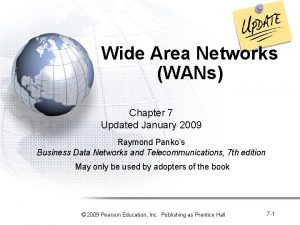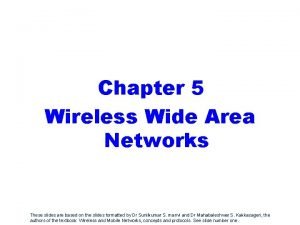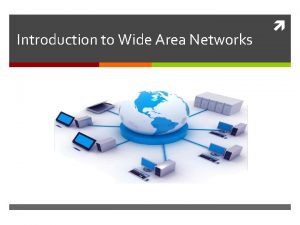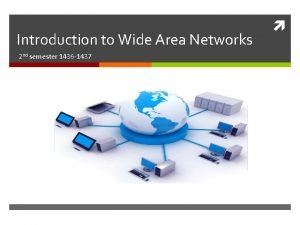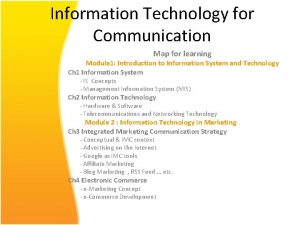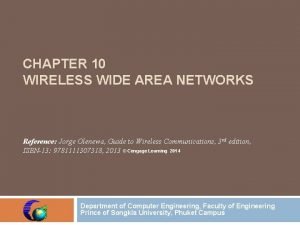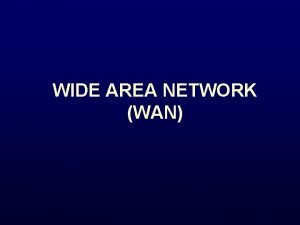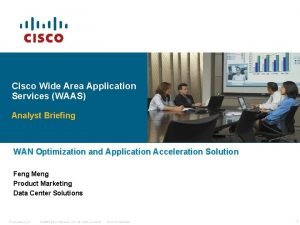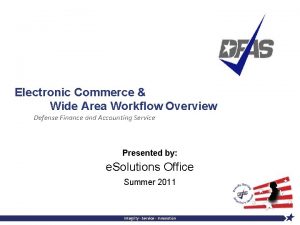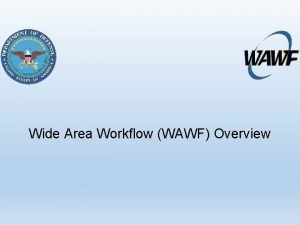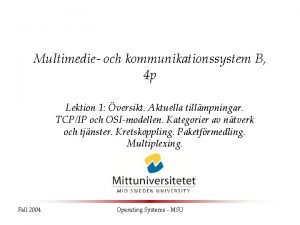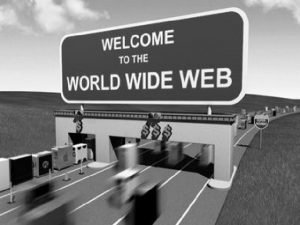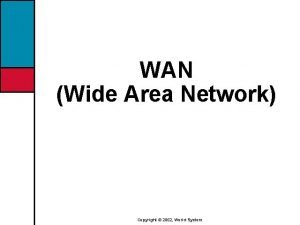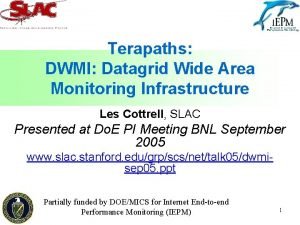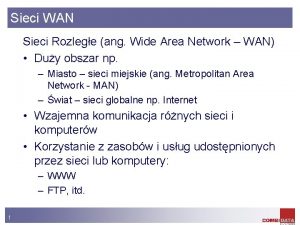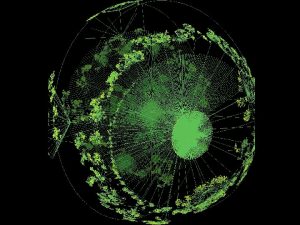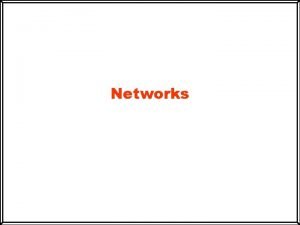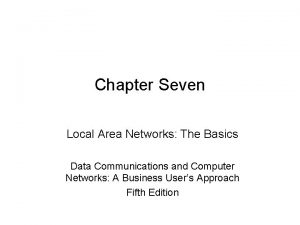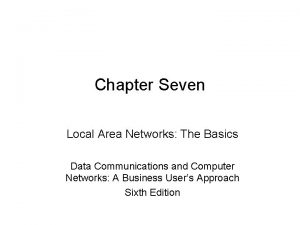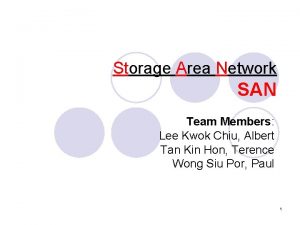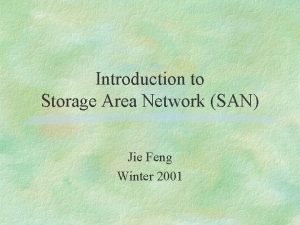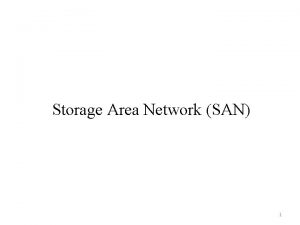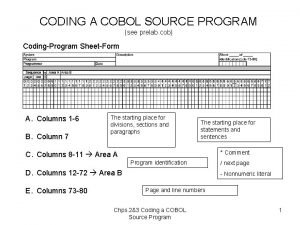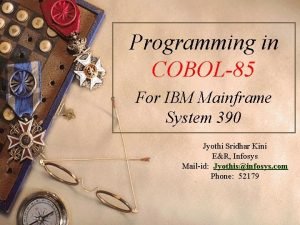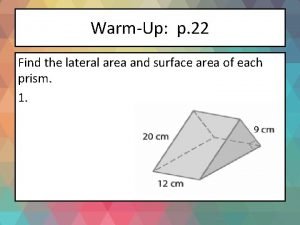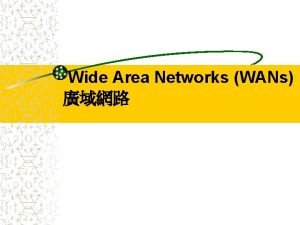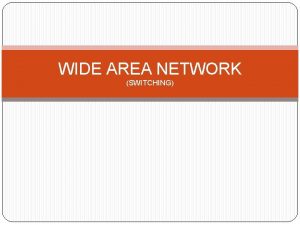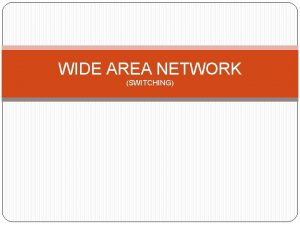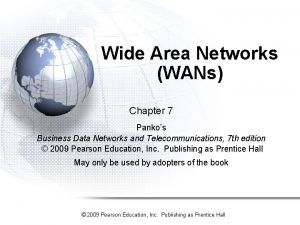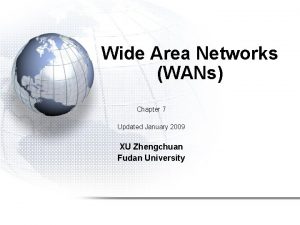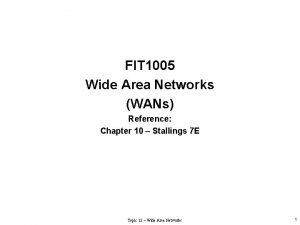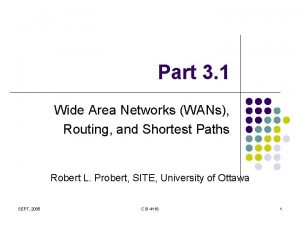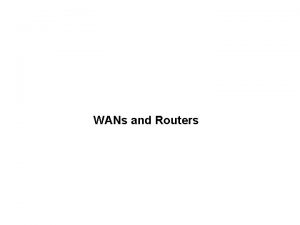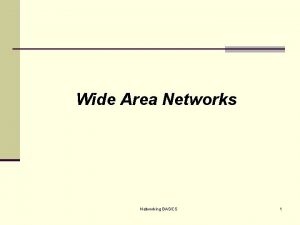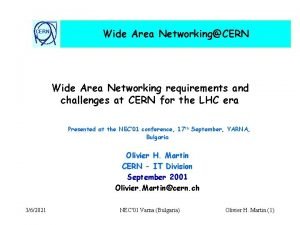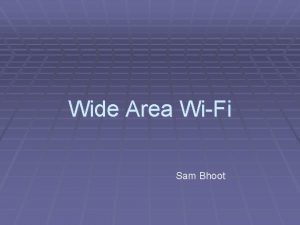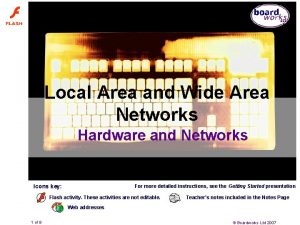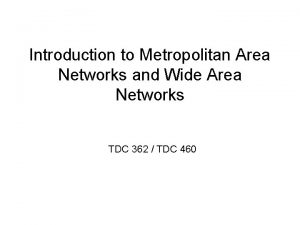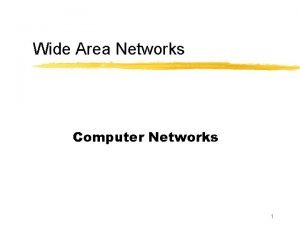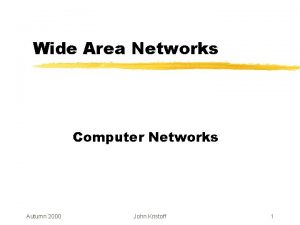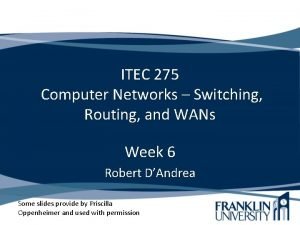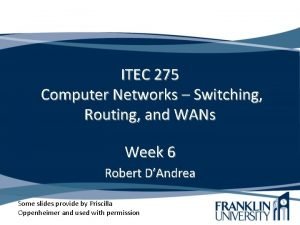Wide Area Networks 1 Wide Area Networks WANs






































- Slides: 38

Wide Area Networks 1

Wide Area Networks (WANs) u WAN Technologies u Ordinary telephone line and telephone modem. u Point-to-Point u Public Leased lines switched data network (PSDN) u Send your data over the Internet securely, using Virtual Private Network (VPN) technology PSDN VPN 2

Evolution of WAN Technology u. Layer 1: Leased line service and networks u. Layer 2: Public switched data networks (PSDN) u. Layer 3: Virtual Private Networks (VPN) over the Internet and IP carrier networks 3

Carriers u Organizations have the right to lay wires in their u Organizations do not have right of ways between u Organizations must turn to a transmission carrier premises sites u Carriers have rights of way. To compensate for this power, they are regulated 4

Transmission Carriers in the U. S. u Domestic Inter-LATA Carriers (U. S. ) u Domestic means within a country u Inter-LATA u Carriers service (between LATAs) are called inter-exchange carriers (IXCs). u Competition has long existed in this arena. IXC 5

Transmission Carriers Between Countries u International Carriers u Called International Common Carriers (ICCs) u Each pair of countries negotiates on what ICCs to allow, like we saw last class meeting. u When you call internationally, you use one ICC, not two--one at each end. ICC 6

POP u All competitors can interconnect their customers into an integrated system u The key to competition u Without it, new competitors could not get a critical mass of customers u With a POP, even a small customer base is no problems, because these customers can reach any other telephone customers in the world. u Trunk lines connect carrier switching offices 7

Connecting to IXCs and ICCs IXC Switching Office Trunk Line POP at LEC Switching Office IXC Switching Office ICC Switching Office The POP also links LEC and CAP subscribers to IXCs and ICCs. 8

Circuit u End-to-End Connection Between Stations u May Pass through Several Switches u May Go Through Multiple Transmission Media u Maintained throughout the call u May flow through multiple carriers u LEC, ICC, etc. Wire Satellite Wire 9

Circuit Speeds u Voice Grade Circuits u Ordinary telephone line, except point-to-point u Analog line: high error rate u Requires modem u Worst of all, slow: Under ~35 kbps Analog 10

Circuit Speeds u 64 Digital 64 kbps 56 kbps Circuits u Digital line: low error rate u If you digitize an analog telephone system, it generates 64 kbps in data u Used to be sufficient for linking people from home u Used to be sufficient for linking branch offices u Sometimes, u Use 56 kbps to be the most widely used digital circuit u Inexpensive. In range of most demand. 11

Circuit Speeds u T 1 1. 544 Mbps Circuits u 1. 544 Mbps u Designed u Can DS 1 to multiplex 24 digital voice lines be used as a single high-speed data pipe u Sufficient u Also for many uses to connect sites called DS 1 for the signaling format u Very widely used: In the critical speed range for many “high speed” corporate uses and not too expensive 12

Circuit Speeds u Fractional u Many u 128 T 1 Circuits firms need between 64 kbps and T 1 speeds kbps, 256 kbps, 384 kbps, 768 kbps common u Each vendor only offers some options u Different u 768 Fractional T 1 128 kbps 256 kbps 384 kbps 768 kbps vendors offer different options kbps usually is the fastest offering 13

Circuit Speeds u T 3 44. 7 Mbps Circuits u 44. 7 Mbps in U. S. u For firms needing very high speeds u Uncommon now but increasing u Other T-Series Speeds u There are faster T-series circuits, but they are rarely used. u There are T 2 circuits, but they are not offered 14

Circuit Speeds u. E E Series 2. 048 Mbps 34. 4 Mbps Series Circuits u Used in Europe, other areas u Created by CEPT (Conference of European Postal and Telecommunications Authorities) u E 1: 2. 048 Mbps (faster than T 1) u E 3: 34. 4 Mbps 15

Circuit Speeds u Higher-Speed u Single u In Digital Lines (SONET/SDH) world-wide standard for very high speeds U. S. , called SONET (Synchronous Optical Network) u In Europe, elsewhere called SDH (Synchronous Digital Hierarchy) u OC circuit designations. Multiples of 51. 84 Mbps u OC 3: u OC 12: 156 Mbps 622 Mbps u Defined SONET SDH up to a few Gigabits per second 16

Types of Traditional Telephone Circuits u Dial-Up u Leased Service (Any-to-Any) Lines u Point-to-point only u Cheaper for high volumes of use Switched Dial-Up Service Seattle Leased Line Washington, D. C. 17

Leased Line Service Leased Lines May Pass Through Multiple Switches, Even Multiple Carriers Switching Office Local Loop Customer Premises A Switching Office Trunk Line Switching Office Local Loop Customer Premises B 18

Leased Lines u Limited to 2 points u Cheaper than dial-up on high-volume routes u Companies can build enterprise networks from meshes of leased lines between sites Corporate-owned Switch Leased Line See this web site for price example 19

Data Networks u Data Networking Alternatives Data Network u Use the telephone network and modems (slow) u Lease lines, add own switching (complex) u Data Networks u Optimized for data transmission u Customer only has to connect to the data network u Carrier handles transmission, switching, management u Shown as cloud to indicate lack of need to know details u Two types: circuit-switched and packet-switched 20

Circuit-Switched Data Networks u Switched u Just for any-to-any communication dial the number of the party being called u Very flexible 21

Circuit-Switched Data Networks u Dedicated u Circuit is maintained during the duration of the call u Capacity u You Capacity is always available must pay for this constant capacity u Most data transmission is burst, with long silences between transmission u Utilization u So of the line may be as low as 5% circuit-switched services is inherently expensive 22

ADSL versus Business-Class Symmetric Digital Subscriber Line (DSL) Services 23

Packet-Switched Data Networks u Messages are Broken into Small Pieces (Packets) u Flow through the network more easily than long messages, like sand in an hourglass Packet 24

Packet Switches u Packet Switched Networks have Switches u Route the packets through the network Switch 1 3 2 4 6 5 7 25

Packet Switching is Efficient u Packets from several stations multiplexed over trunk lines between switches u No costly dedicated transmission capacity 1 2 Trunk Line 26

Error Checking in Packet-Switched Data Networks u The Process u Sender transmits the packet u Sender maintains the packet in memory u Receiver u If 1 2 checks the packet for errors there is an error, asks for a retransmission u Sender retrieves from memory, retransmits 27

Error Checking in Packet-Switched Data Networks u Considerations u Adds in delay (latency) every time it is done u Places a heavy load on the switch, lowering throughput u Not often needed, because there are very few errors on modern transmission lines. 28

Reliable Packet-Switched Data Networks u Check for Errors at Each Hop u Have reduced throughput u Have latency (delays) Error Check Error Check 1 2 3 4 5 29

Unreliable Packet-Switched Data Networks u No Error Check at Each Packet Switch u Check only once, at receiving host u Low latency, load on switches Error Check No Error Checks at Switches 1 2 3 4 5 30

Unreliable Service u Most Packet Switched Networks Today are Unreliable u Little Need: Error rates are low with modern lines, switches u Reduces u Low delays: critical for some applications load on the switches for high throughput u Better to check once, on the receiving host, than at every switch 31

Connectionless Service u Routing Decision for each packet at each switch u Places a heavy load on switches u Unnecessary work: subsequent packets usually travel same path, because conditions rarely change between packets Decision 1 Decision 3 2 4 6 Decision 5 See some Level 3 services 7 Decision 32

Connection-Oriented Service u Routing decision is made once, at start of connection Decision 1 Decision 3 2 4 6 Decision 5 7 Decision 33

Connection-Oriented Service u First decision establishes a path (virtual circuit) u All subsequent packets follow the virtual circuit 1 3 2 4 6 Virtual Circuit 5 7 34

Connection-Oriented Packet-Switched Data Networks u All Commercial Packet Switched Networks are Connection-Oriented u Reduces u Lower loads on the switches for higher throughput latency because of less work at each switch u When marketers say “packet switched, ” they now automatically include the concept of connection orientation 35

Connections in Packet-Switched Data Networks u Permanent Virtual Circuits (PVCs) u Established for long durations u Set up weeks or months ahead of time u If your firm has four sites, need 6 PVCs u Makes packet switched networks like network of leased lines PVC Site 1 Site 2 Site 3 Site 4 36

Connections in Packet-Switched Data Networks u Switched Virtual Circuits u Established u Only at call setup available in some packet switched networks u Will provide the any-to-any flexibility of circuitswitched data networks AND the efficiency of connection-oriented packet switching 37

OSI Layering u Connectionless Service u OSI Layer 3 (Networking) u Routing across a series of packet switches u Alternative Routing u Connection-Oriented Service u OSI Layer 2 (Data Link) u Reduces network to a single path u Loses flexibility of alternative routing after virtual circuit is established 38
 7th wans
7th wans Wireless wide area network
Wireless wide area network Introduction to wide area networks
Introduction to wide area networks Introduction to wide area networks
Introduction to wide area networks Noddy shot example
Noddy shot example Difference between virtual circuit and datagram networks
Difference between virtual circuit and datagram networks Backbone networks in computer networks
Backbone networks in computer networks Wide area
Wide area Wireless wide area network
Wireless wide area network Mobile wide area network
Mobile wide area network Wide area network adalah
Wide area network adalah Cisco wide area application services
Cisco wide area application services Wawf acceptor training
Wawf acceptor training Wawf
Wawf Wide area kommunikationssystem
Wide area kommunikationssystem Components of world wide web
Components of world wide web Wide area work flow
Wide area work flow Wide area monitoring
Wide area monitoring Wan wide area network
Wan wide area network Wide area network example
Wide area network example Wide area kommunikationssystem
Wide area kommunikationssystem Wide area network wan fort myers
Wide area network wan fort myers Local area network topology
Local area network topology What are the basic layouts of local area networks
What are the basic layouts of local area networks What are the basic layouts of local area networks
What are the basic layouts of local area networks Storage area networks tutorial
Storage area networks tutorial санмодуль
санмодуль Evolution of storage area network
Evolution of storage area network San storage definition
San storage definition Cobol area a and area b
Cobol area a and area b Mandibular edentulous landmarks
Mandibular edentulous landmarks Ibm system/390
Ibm system/390 Area nervina area radicularis
Area nervina area radicularis Gastrulation in fishes
Gastrulation in fishes Find the lateral area and surface area of each prism
Find the lateral area and surface area of each prism Volume and surface area of cone
Volume and surface area of cone What is lateral face
What is lateral face How to find lateral area
How to find lateral area Area radicularis
Area radicularis
